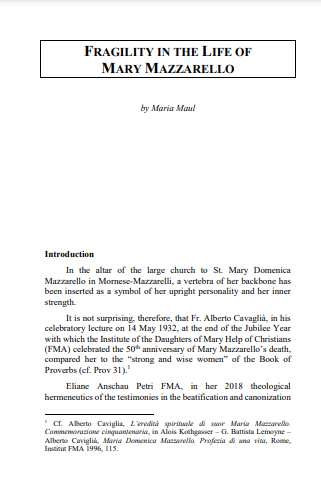In the altar of the large church to St. Mary Domenica Mazzarello in Mornese-Mazzarelli, a vertebra of her backbone has been inserted as a symbol of her upright personality and her inner strength. It is not surprising, therefore, that Fr. Alberto Cavaglià, in his celebratory lecture on 14 May 1932, at the end of the Jubilee Year with which the Institute of the Daughters of Mary Help of Christians (FMA) celebrated the 50th anniversary of Mary Mazzarello’s death, compared her to the “strong and wise women” of the Book of Proverbs (cf. Prov 31). This article does not offer a scholarly study of this topic, but is limited to a careful reading of the primary sources of the FMA Institute, especially the letters of Mary Mazzarello and the first three volumes of the Cronistoria, supplemented by references to some recent studies. The traces of fragility that can be found in them will be exemplified in what follows
Nell’altare della chiesa grande a S. Maria Domenica Mazzarello in Mornese-Mazzarelli, è stata inserita una vertebra della sua spina dorsale come simbolo della sua retta personalità e della sua forza interiore. Non sorprende, quindi, che p. Alberto Cavaglià, nella sua conferenza celebrativa il 14 maggio 1932, al termine dell’anno giubilare con cui l’Istituto delle Figlie di Maria Ausiliatrice (FMA) ha celebrato il 50° anniversario della morte di Maria Mazzarello, la paragonò alle “donne forti e sagge” del Libro di Proverbi (cfr. Prov 31).
Questo articolo non offre uno studio accademico su questo argomento, ma si è limitato ad una lettura attenta delle fonti primarie dell’Istituto delle FMA, in particolare le lettere di Maria Mazzarello e i primi tre volumi della Cronistoria, integrati da riferimenti ad alcuni studi recenti. Le tracce di fragilità che si possono trovare in esse saranno semplificate in quanto segue.
Contents:
- Introduction
- 1. Experiences of fragility
- 1.1. Precarious health
- 1.1.1. Mary Mazzarello’s existential health crisis
- 1.1.2. Dangerous diseases among the first Daughters of Mary Help of Christians
- 1.2. Damaged teenage orphans
- 1.3. Mental abnormalities
- 1.4. Inconsistency in relation to vocation
- 1.5. Disturbed relations
- 1.5.1. With the Daughters of the Immaculate
- 1.5.2. With the residents of Mornese and Nizza Monferrato
- 1.6. Painful detachments
- 1.7. Frequent deaths
- 1.1. Precarious health
- 2. From fragility to “religious resilience”
- 2.1. Devotion to God in one’s own fragilities
- 2.1.1. Sickness and death
- 2.1.2. Sadness
- 2.1.3. Feeling of her own inadequacy
- 2.2. Encouraging fellow sisters in their fragilities
- 2.3. Serenity in fragile situations
- 2.1. Devotion to God in one’s own fragilities
- 3. Through fragility to holiness
- 3.1. Maturing of virtue through difficulties
- 3.2. Love for Jesus crucified
- 3.3. Experience of the power of God in one’s own weakness
- Conclusion
Reference time period: 1837 – 1881
M. Maul, Fragility in the life of Mary Mazzarello, in «Journal of Salesian Studies» 19 (2021), 39-76.
Reference institution:
Institute of Salesian Studies
